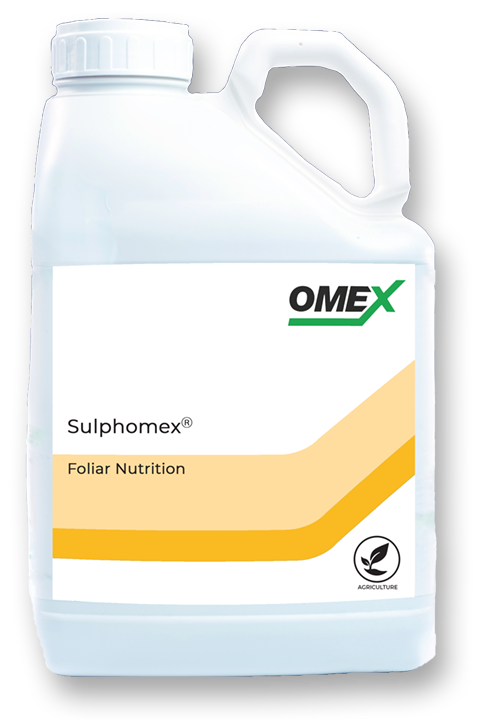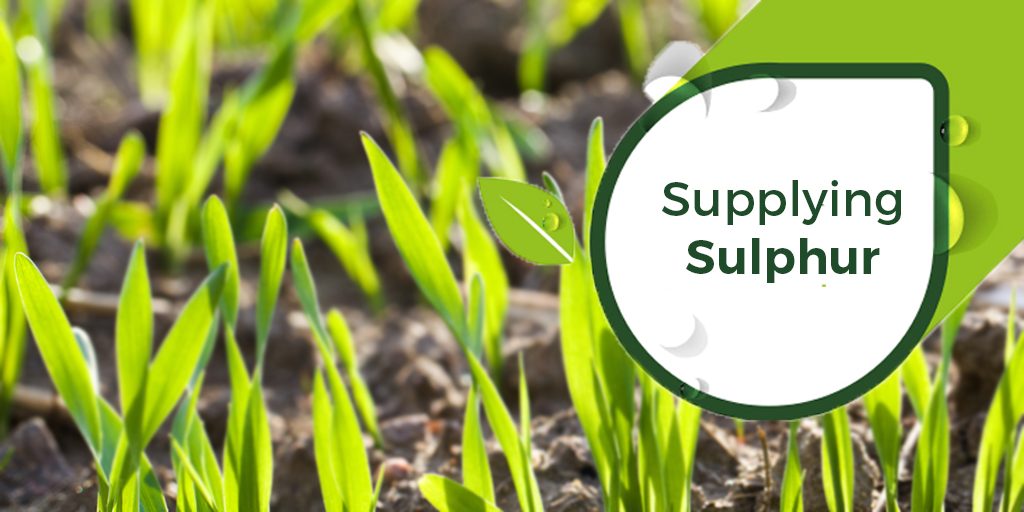Supplying Sulphur to your crops
Sulphur is a key component when growing high yielding, healthy crops. Whilst Nitrogen is a growth promoter, Sulphur works as a growth regulator, effectively balancing the manufacture of sugars and proteins in leaf tissue with the demand from these materials throughout the plant. Consequently, Sulphur plays a crucial role in maintaining green leaf area, growth rates and delaying senescence. Low Sulphur levels reduce Nitrogen metabolism, leaf expansion and plant development. The nutrient is very mobile in the soil meaning wet winters and early springs leave low reserves in the soil. Crops need a steady supply throughout rapid growing seasons, so it's key to apply S each time N is applied.
 Sulphomex
Sulphomex is used to correct sulphur deficiency, or as part of a programme to prevent sulphur deficiency. It should be used when deficiency is diagnosed or suspected. Refer to individual crop recommendations for timings.
Speak to your local Liquid Fertiliser Expert when deciding which foliar fertiliser product is relevant to your crop.
Sulphomex
Sulphomex is used to correct sulphur deficiency, or as part of a programme to prevent sulphur deficiency. It should be used when deficiency is diagnosed or suspected. Refer to individual crop recommendations for timings.
Speak to your local Liquid Fertiliser Expert when deciding which foliar fertiliser product is relevant to your crop.
Steadily Supplying Sulphur to the crop
Sulphur deposition has decreased dramatically throughout the UK over the last 30 years, as a result of the Clean Air Act. Deficiencies of this vital element are now visible in many areas of the UK. Where deposition is less than 10kg/ha/year most crops will benefit from applications of fertiliser containing sulphur.The Nitroflo Range
Sulphur can be applied alongside Nitrogen, when using the OMEX Nitroflo range of Liquid fertilisers. The Nitroflo range offers tailored a range of N+S solutions: Nitroflo 28+S - containing nitrogen and a low level (2.5% S03) of sulphur. Nitroflo 26+S - containing nitrogen and 5% SO3 sulphur; for top-dressing sulphur responsive crops in the spring during periods of rapid growth and ensuring strong, even growth. The sulphur source is sulphate. The most widely used product in the Nitroflo range. Nitroflo 24+S - containing nitrogen and a higher level of S (7.5% S03) than Nitroflo 26+S. The sulphur source is sulphate. Nitroflo 22+S - containing nitrogen and a higher level of S (10% S03) than Nitroflo 24+S. The sulphur source is sulphate. Nitroflo 20+S - containing a higher level of sulphur (12.5% S03) for deficient areas and crops with a high demand for sulphur, such as oilseed rape. The sulphur source is sulphate. Nitroflo 15+S - containing an equal amount of nitrogen and sulphur; ideal for first nitrogen application on oilseed rape. The sulphur source is sulphate.Suspension Fertilisers
Application of Sulphur can also be made using OMEX Suspension Fertilisers. Suspension Ferilisers offer farmers a bespoke nutritional service, meaning the crop receives exactly what it needs to grow. Using the free soil sampling service OMEX provide, you're able to gain a true understanding of the Sulphur requirements for the season. Suspension Fertilisers offer tailor made nutrition, and are applied by a contractor service, meaning they're a useful time management tool.Foliar Fertilisers
Foliar fertilisers are ideal for offering the crop a boost of nutrition, whether that be maintaining crop health or during times of stress. Foliar fertilisers bypass limiting soil conditions and prevent nutrient deficiency. They work by targeting specific organs, alleviating stress situations and boost growth during critical stages of plant development. Sulphomex
Sulphomex is used to correct sulphur deficiency, or as part of a programme to prevent sulphur deficiency. It should be used when deficiency is diagnosed or suspected. Refer to individual crop recommendations for timings.
Speak to your local Liquid Fertiliser Expert when deciding which foliar fertiliser product is relevant to your crop.
Sulphomex
Sulphomex is used to correct sulphur deficiency, or as part of a programme to prevent sulphur deficiency. It should be used when deficiency is diagnosed or suspected. Refer to individual crop recommendations for timings.
Speak to your local Liquid Fertiliser Expert when deciding which foliar fertiliser product is relevant to your crop.
